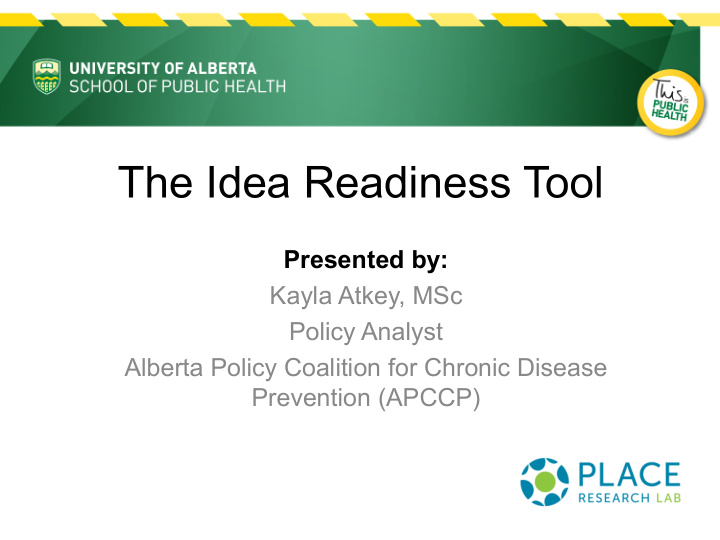



The Idea Readiness Tool Presented by: Kayla Atkey, MSc Policy Analyst Alberta Policy Coalition for Chronic Disease Prevention (APCCP)
Idea Readiness Tool • An evidence-based tool to help get new ideas off the ground in a school community (e.g., individual school, school board, school district, etc.) – Examples of new ideas: • Practice, • Initiative, • Policy, • Product, • Etc. *As long as the new idea in question is considered new by the school community considering its adoption. 2
How Was the Tool Developed? • Modified the evidence-based Policy Readiness Tool • Uses Rogers’ “diffusion of innovations theory” to make participating in the idea change process more accessible 3
Diffusion of Innovations = a theory that is used to examine how something new spreads from place to place over time
What is Level of Innovation? The degree to which an adopter is relatively earlier or later in taking up new ideas than other members of a system. 5
Idea Readiness Tool • Includes three key parts: (1) Checklist: Identify a school community’s readiness for a new idea (2) Strategies: Specifically tailored for working with school communities at different stages of readiness (3) Resources: Information to support the strategies 6
Idea Readiness Tool • Includes three key parts: (1) Checklist: Identify a school community’s readiness for a new idea (2) Strategies: Specifically tailored for working with school communities at different stages of readiness (3) Resources: Information to support the strategies 7
8
“Readiness” Categories • Use of 3 categories eases applicability: – Innovators – Majority – Late Adopters Readiness = relative tolerance for risk for a new idea It is NOT static & can be different from issue to issue 9
Using the Idea Readiness Tool: “Adopter Categories” 10
Innovators • Are described as “adventurous” and often serve as initiators or role models within their social networks - Attracted by high- reward initiatives and are “risk - takers” - Can cope with elevated levels of uncertainty associated with the new idea - Typically willing to cope with initial problems & able to identify solutions to these problems 11
The Majority • Are described as “deliberate” because they require time to consider the evidence and determine whether to adopt a new idea - Seldom lead the pack - Is often of the philosophy that it is better to change as a group than to be one of the first to change - Tend to adopt new ideas at about the same time as the average adopter 12
Late Adopters • Are described as “traditional” and may be skeptical of new ideas (without substantial evidence) or eager to maintain the status quo - Usually wait until the majority of others have adopted a new idea - May need to be pressured into the adoption of a new idea - May never adopt the idea unless required to 13
“Readiness” Categories - Caveats • Not a value judgment about a school community There is no good or bad adopter category! • Instead, the Tool offers an efficient way to select appropriate strategies to support the development of a new idea Not a one-size-fits-all solution, but a place to start! 14
Idea Readiness Tool • Includes three key parts: (1) Checklist: Identify a school community’s readiness for a new idea (2) Strategies: Specifically tailored for working with school communities at different stages of readiness (3) Resources: Information to support the strategies Readiness = relative tolerance for risk for a new idea It is NOT static & can be different from issue to issue 15
16
Idea Readiness Tool • Includes three key parts: (1) Checklist: Identify a school community’s readiness for a new idea (2) Strategies: Specifically tailored for working with school communities at different stages of readiness (3) Resources: Information to support the strategies Readiness = relative tolerance for risk for a new idea It is NOT static & can be different from issue to issue 17
18
Using the Idea Readiness Tool Let’s try it together… • Complete the short checklist found in your package • Choose the ‘closest’ description (A, B, or C) in each row • Tally up the total number of As, Bs and Cs. 19
Potential Bottlenecks • What if I am unsure about which option to select? Pick the best option for right now or leave the question blank. Do the best that you can. • Why do some of the descriptions seem the same? This was done purposively to gain a comprehensive understanding of your target school community and its innovation characteristics. 20
Using the Idea Readiness Tool Using your knowledge, expertise and experience and the strategies outlined in the Idea Readiness Tool, discuss how you would go about facilitating the uptake of your new idea in a school community. 21
Applying the Tool: Strengths Increasing Local Capacity for the Uptake of New Ideas 1) Builds personal and school capacity Increase knowledge, skills & leadership 2) Addresses the resource capacity issues of schools Focus on effective use of limited resources via tailored strategies 3) Builds knowledge through collaboration Encourage those from different school communities to consider new ideas 22
Applying the Tool: Limitations • Diffusion theory is uni-directional, time-specific, and linear - Static instrument explaining a dynamic process, which may still be ongoing at time of “readiness” assessment • Most applicable to simple (single issue) and straight- forward cases of idea change • Caveat - users must remain flexible and leave room to act on the unexpected! 23
Acknowledgements The team would like to thank the Alberta School Employee Benefits Plan (ASEBP) Prevention Services Team for their invaluable feedback on drafts of the Idea Readiness Tool. 24
For more information or conversation: Dr. Candace Nykiforuk Associate Professor, School of Public Health, University of Alberta CIHR/PHAC/AI-HS Applied Public Health Chair E: candace.nykiforuk@ualberta.ca E: prt.info@ualberta.ca www.policyreadinesstool.com Kayla Atkey, MSc Policy Analyst Alberta Policy Coalition for Chronic Disease Prevention E: kayla.atkey@ualberta.ca 25
Recommend
More recommend